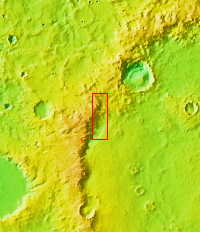
Context imageAll this week, the THEMIS Image of the Day is following on the real Mars the path taken by fictional astronaut Mark Watney, stranded on the Red Planet in the book and movie, The Martian.
Today's image shows part of the northwest rim of Schiaparelli Crater. Schiaparelli is a large, ancient impact scar, some 480 kilometers (280 miles) wide. It has been much modified by billions of years of erosion and deposition by wind and probably water.
For astronaut Mark Watney, the descent from the rim onto the crater floor looks smooth and gradual. But it almost wrecks his rover vehicle when he drives into soft sediments. His goal? An automated rescue rocket, intended for the next Mars expedition, which stands about 250 kilometers (150 miles) away on the southern part of Schiaparelli's floor.
Orbit Number: 10910 Latitude: -0.882761 Longitude: 13.4529 Instrument: VIS Captured: 2004-05-30 15:45
Please see the THEMIS Data Citation Note for details on crediting THEMIS images.
NASA's Jet Propulsion Laboratory manages the 2001 Mars Odyssey mission for NASA's Science Mission Directorate, Washington, D.C. The Thermal Emission Imaging System (THEMIS) was developed by Arizona State University, Tempe, in collaboration with Raytheon Santa Barbara Remote Sensing. The THEMIS investigation is led by Dr. Philip Christensen at Arizona State University. Lockheed Martin Astronautics, Denver, is the prime contractor for the Odyssey project, and developed and built the orbiter. Mission operations are conducted jointly from Lockheed Martin and from JPL, a division of the California Institute of Technology in Pasadena.

